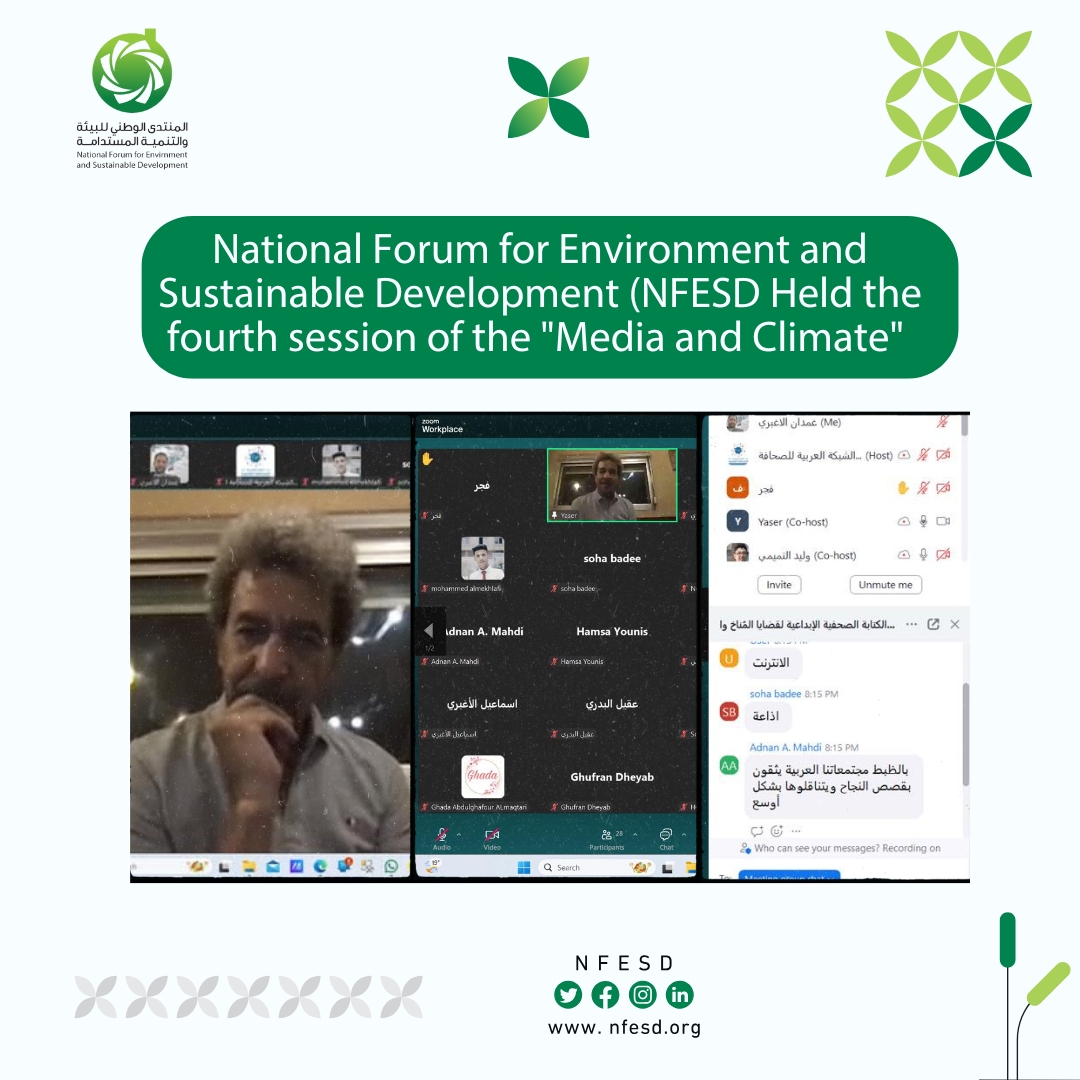National Forum for Environment and Sustainable Development (NFESD) Held the fourth session of the “Media and Climate”
And collaboration with the Arab Network for Scientific Journalism and the Humanitarian Journalism Foundation. The session took place on the Zoom platform under the title “Creative Journalism for Climate and Environmental Issues.”
This session focused on how to produce creative journalistic stories on environmental and climate issues in a way that makes them engaging and shareable among the public. The trainer, journalist Yasser Al-Zayyat, who specializes in digital storytelling and previously served as editor-in-chief of the Arab Reporters for Investigative Journalism (ARIJ), led the session.
During the session, Al-Zayyat explained why audiences tend to avoid consuming stories related to environmental and climate issues. He noted that many people are deterred due to the choice and arrangement of sources they expect to see.
He added that audiences want to hear their own voices rather than those of experts and prefer to see people who resemble them, making such sources more credible in their eyes. Understanding the audience is crucial for effectively reaching them with journalistic stories; however, many journalists fail to grasp their audience, which weakens engagement with stories about environmental and climate issues or other topics.
Al-Zayyat outlined the types of sources that can enhance the success of journalistic stories. Among the most effective sources are “people like us,” as audiences prefer to hear from individuals who mirror their experiences. Following them are “celebrities,” as the public is drawn to well-known figures who share similar struggles.
Next are “influencers” on social media, who typically have higher credibility due to their authenticity, which is essential in storytelling. Finally, “experts” are listed last, as they are easily accessible but often lack the relatability that engages the audience.
He emphasized that the selection and arrangement of sources are fundamental to conveying messages effectively, stating that information alone does not suffice; dry facts do not achieve the intended impact of a journalistic story.
Al-Zayyat pointed out the psychological sensitivities of audiences regarding sources, noting that some may feel belittled by the way experts communicate. It’s essential to address the audience in a relatable language that avoids condescension and does not employ overly complex scientific jargon.
The session facilitator, journalist Walid Al-Tamimi, highlighted the recent disasters and floods affecting several areas in Yemen, particularly in Al-Hudaydah and Al-Mahwit due to heavy rains that submerged entire villages. He remarked that these natural disasters, manifesting as floods and rains, are closely tied to the session’s theme and encourage journalists to cover such events.
In this regard, Al-Zayyat emphasized the need for future investigations into disasters and developing awareness plans to mitigate them.
Responding to a question from a trainee about “building in flood channels in Yemen” and the ensuing risks for journalists caught between societal ignorance and governmental corruption, Al-Zayyat stated: “We should not blame the victims in such cases, but rather those responsible for keeping citizens uninformed. The citizen has not learned and sees their parents doing the same; they are unaware of the risks, and the authorities have not provided suitable environments for construction.”
He continued, “The responsibility lies with the legislative authority for not enacting laws to regulate construction, or with the executive authority if laws exist but corruption prevails. Additionally, the Ministry of Health must warn and educate about the dangers of building in flood channels.”
He reiterated that it is not a journalist’s role to provide solutions; their primary duty is to highlight and warn. Authorities should heed what journalism presents, but if a journalist chooses to propose solutions, they should not frame them as advice.
Highlighting personal interest is a vital means of educating the community about environmental and climate issues, says Al-Zayyat, noting that success in a story or awareness campaign hinges on this.
He stressed the importance of finding the right angle to convince victims and the audience that disasters are linked to climate change and the necessity of selecting the appropriate medium for storytelling, targeting the audience through relevant and impactful channels, whether through newspapers, television, radio, or online platforms.
Al-Zayyat emphasized the need for journalists to maintain a spirit of amateurism, avoiding a desire for professional status, as storytelling does not require innate talent; any journalist can learn to write and tell stories. Those struggling can improve with training and practice, as storytelling is a human instinct.
He concluded with a message: cover environmental and climate issues to raise awareness and mitigate disasters arising from climate change. Every journalist must believe in the message they deliver to the public, presenting understandable information and using simplified language that is not demeaning, as simpler language enhances the effectiveness of the message.
This session was the fourth in the “Media and Climate” program launched by the National Forum for Environment and Sustainable Development (NFESD) in collaboration with the Arab Network for Scientific Journalism and the Humanitarian Journalism Foundation, aimed at enhancing journalists’ capacities to address topics related to environmental and climate issues.

